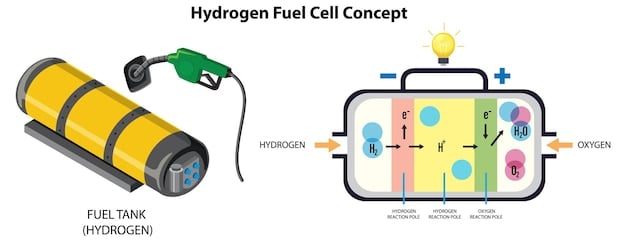Hydrogen Fuel Cells in US Transportation: A 2025 Status Report

Will Hydrogen Fuel Cells Power the Future of US Transportation? A 2025 status report indicates that while hydrogen fuel cells have made significant strides, challenges remain in infrastructure development and cost reduction for widespread adoption in the US transportation sector.
The quest for sustainable transportation solutions has led to significant interest in hydrogen fuel cells. But, will hydrogen fuel cells power the future of US transportation? A 2025 status report sheds light on the promises and hurdles that lie ahead.
Hydrogen Fuel Cell Technology: An Overview
Hydrogen fuel cell technology represents a pivotal shift towards clean energy, offering a promising alternative to traditional combustion engines. This technology harnesses the chemical energy of hydrogen to produce electricity, with water being the primary byproduct.
Understanding the fundamentals of hydrogen fuel cell technology is crucial to grasping its potential impact on the future of US transportation. This section delves into the basic principles, advantages, and challenges associated with this innovative energy solution.
The Science Behind Hydrogen Fuel Cells
At its core, a hydrogen fuel cell operates on a simple electrochemical reaction. Hydrogen molecules are split into protons and electrons at the anode. The protons travel through an electrolyte membrane to the cathode, while the electrons flow through an external circuit, generating electricity.
When the protons and electrons meet at the cathode, they combine with oxygen from the air to produce water. This process is clean and efficient, with no harmful emissions other than water vapor.
Advantages of Hydrogen Fuel Cells
Hydrogen fuel cells offer several compelling advantages over conventional technologies. These advantages include zero tailpipe emissions, high energy efficiency, and the potential for rapid refueling.
- Zero Emissions: Fuel cells produce only water and heat as byproducts, eliminating harmful pollutants associated with combustion engines.
- High Efficiency: Fuel cells can convert a higher percentage of fuel into energy compared to internal combustion engines.
- Fast Refueling: Hydrogen vehicles can be refueled in a matter of minutes, similar to gasoline or diesel vehicles.
In conclusion, hydrogen fuel cell technology presents a clean, efficient, and sustainable solution for powering vehicles. The further development and adoption of this technology could significantly reduce greenhouse gas emissions and improve air quality in the US.

Current State of Hydrogen Fuel Cell Vehicles in the US (2025)
As of 2025, hydrogen fuel cell vehicles (FCVs) have made inroads into the US transportation sector, though their adoption remains limited compared to battery electric vehicles (BEVs). Several automakers offer FCV models, primarily in regions with established hydrogen refueling infrastructure.
This section provides an overview of the current availability and market penetration of FCVs in the US, highlighting key models, regional adoption trends, and infrastructure challenges.
Available FCV Models
While the selection of FCVs is still smaller than that of BEVs, several manufacturers have introduced hydrogen-powered vehicles. These models primarily target the passenger vehicle market, with some applications in public transportation and commercial fleets.
Notable FCV models available in the US include the Toyota Mirai and the Hyundai Nexo. These vehicles offer a range of over 300 miles on a single tank of hydrogen and can be refueled in approximately five minutes.
Regional Adoption and Infrastructure
The adoption of FCVs in the US is largely concentrated in California, which has the most extensive network of hydrogen refueling stations. Other states, such as Hawaii and some Northeastern states, are exploring hydrogen infrastructure development.
- California: Leads the nation in hydrogen refueling stations and FCV adoption, driven by state incentives and clean air regulations.
- Hawaii: Exploring hydrogen as a potential energy source for transportation and grid stabilization, leveraging renewable energy resources for hydrogen production.
- Northeastern States: Some states are investing in hydrogen infrastructure to support the transition to clean transportation.
In summary, while FCVs are available in the US market, their adoption is limited by the availability of hydrogen refueling infrastructure and the higher upfront cost compared to conventional vehicles. Addressing these challenges is crucial for the widespread adoption of FCVs.
The Hydrogen Refueling Infrastructure Challenge
One of the most significant barriers to the widespread adoption of hydrogen fuel cell vehicles is the limited availability of hydrogen refueling infrastructure. Building a robust and accessible network of refueling stations is essential for enabling the widespread use of FCVs.
This section examines the current state of hydrogen refueling infrastructure in the US, the challenges associated with its expansion, and potential solutions for overcoming these obstacles.
Current Infrastructure Status
As of 2025, the majority of hydrogen refueling stations in the US are located in California. These stations primarily serve passenger vehicles, with some stations also catering to buses and commercial vehicles.
Outside of California, the availability of hydrogen refueling stations is extremely limited. This lack of infrastructure discourages potential FCV buyers and hinders the growth of the hydrogen vehicle market.
Challenges in Infrastructure Expansion
Expanding the hydrogen refueling infrastructure presents several challenges, including high capital costs, regulatory hurdles, and public perception.
- High Capital Costs: Building hydrogen refueling stations requires significant investment in specialized equipment and infrastructure.
- Regulatory Hurdles: Permitting and regulatory processes can be complex and time-consuming, slowing down the deployment of new stations.
- Public Perception: Concerns about safety and the environmental impact of hydrogen production can create resistance to the development of new refueling stations.
In conclusion, overcoming the hydrogen refueling infrastructure challenge requires a concerted effort from government, industry, and the public. Investments in infrastructure development, streamlined regulatory processes, and public education campaigns are essential.
Cost Analysis: Hydrogen Fuel Cells vs. Other Technologies
The cost of hydrogen fuel cell technology is a critical factor influencing its competitiveness in the transportation market. Comparing the costs of FCVs to those of battery electric vehicles (BEVs) and internal combustion engine vehicles (ICEVs) provides valuable insights.
This section analyzes the various cost components of FCVs, including vehicle purchase price, fuel costs, and maintenance expenses, and compares them to the costs of alternative technologies.
Vehicle Purchase Price
Currently, FCVs tend to have a higher upfront purchase price compared to both BEVs and ICEVs. This higher cost reflects the advanced technology and relatively low production volumes of FCVs.
However, as production volumes increase and technology matures, the purchase price of FCVs is expected to decrease. Government incentives and subsidies can also help to offset the higher upfront cost.
Fuel Costs
The cost of hydrogen fuel is another important consideration. Hydrogen prices vary depending on the production method, transportation costs, and local market conditions.
In some regions, hydrogen fuel costs are competitive with gasoline prices. However, in other areas, hydrogen can be more expensive. The development of lower-cost hydrogen production methods, such as electrolysis powered by renewable energy, could help to reduce fuel costs.
Maintenance Expenses
FCVs generally have lower maintenance expenses compared to ICEVs due to their simpler mechanical design. Fuel cells have fewer moving parts and do not require oil changes or other routine maintenance tasks associated with combustion engines.

In summary, while FCVs currently have a higher upfront cost, their lower maintenance expenses and potential for lower fuel costs could make them competitive with other technologies in the long run. Continuous technological advancements and economies of scale are expected to further reduce the total cost of ownership for FCVs.
Government Policies and Incentives Supporting Hydrogen Fuel Cells
Government policies and incentives play a crucial role in promoting the adoption of hydrogen fuel cell technology. Supportive policies can help to overcome market barriers, stimulate investment, and accelerate the transition to a hydrogen economy.
This section examines the various government policies and incentives currently in place in the US, including tax credits, grants, and regulatory frameworks, and their impact on the hydrogen fuel cell industry.
Federal Incentives
The federal government offers several incentives to support the development and deployment of hydrogen fuel cell technology. These incentives include tax credits for the purchase of FCVs and investments in hydrogen production and infrastructure.
The Inflation Reduction Act of 2022 includes significant provisions for clean energy, including incentives for hydrogen production and the deployment of zero-emission vehicles.
State Incentives
Many states also offer incentives to promote hydrogen fuel cell technology. These incentives vary by state and may include tax credits, rebates, and grants.
California, for example, offers rebates for the purchase of FCVs and provides funding for hydrogen refueling infrastructure development.
- Tax Credits: Reduces the upfront cost of FCVs and encourages investment in hydrogen infrastructure.
- Rebates: Provides direct financial assistance to consumers who purchase FCVs.
- Grants: Supports research and development of hydrogen technologies and the deployment of hydrogen infrastructure.
In conclusion, government policies and incentives are essential for supporting the growth of the hydrogen fuel cell industry. These policies can help to level the playing field, stimulate innovation, and accelerate the transition to a clean energy future.
| Key Point | Brief Description |
|---|---|
| 💡 Zero Emissions | FCVs produce only water vapor, reducing air pollution. |
| ⛽ Fast Refueling | FCVs can be refueled in minutes, similar to gasoline cars. |
| 💰 High Costs | FCVs have higher initial costs than gasoline or electric cars. |
| 🚧 Infrastructure | Limited hydrogen refueling stations hinder FCV adoption. |
Frequently Asked Questions
▼
A hydrogen fuel cell is an electrochemical device that combines hydrogen and oxygen to produce electricity, with water and heat as byproducts, offering a clean energy alternative.
▼
Hydrogen fuel cells offer zero tailpipe emissions, high energy efficiency, and fast refueling times, making them an attractive option for sustainable transportation.
▼
The high cost of fuel cell vehicles, the limited availability of hydrogen refueling infrastructure, and public perception are key challenges to broader adoption.
▼
Hydrogen fuel cell vehicles are primarily available in California, which has the most extensive network of hydrogen refueling stations. Other states are exploring hydrogen development.
▼
Government policies and incentives, such as tax credits, rebates, and grants, help reduce the upfront cost of FCVs and encourage investment in hydrogen infrastructure.
Conclusion
In summary, while hydrogen fuel cells hold significant promise for the future of US transportation, challenges remain in infrastructure development and cost reduction. Continued innovation, supportive government policies, and strategic investments are crucial for realizing the full potential of hydrogen as a clean and sustainable energy source.





